Commercial Law Assignment: Tort of Negligence, Damages, and ACL
VerifiedAdded on 2021/05/31
|8
|2696
|171
Homework Assignment
AI Summary
This commercial law assignment addresses key legal concepts. The first answer defines the tort of negligence, outlining essential elements like duty of care, breach of duty, and damages, along with the manufacturer's product liability. The second answer discusses the Australian Law Reform Commission's (ALRC) proposal for damage caps, analyzing their purpose, the varying perspectives on their fairness, and their impact on business costs and litigation. The final answer examines the Australian Consumer Law (ACL), specifically Part 3-5 concerning manufacturer liability for product safety defects, explaining the conditions for establishing liability, consumer rights, and the absence of criminal provisions within the ACL. The assignment provides a detailed analysis of negligence, damages, and consumer protection within the framework of commercial law.
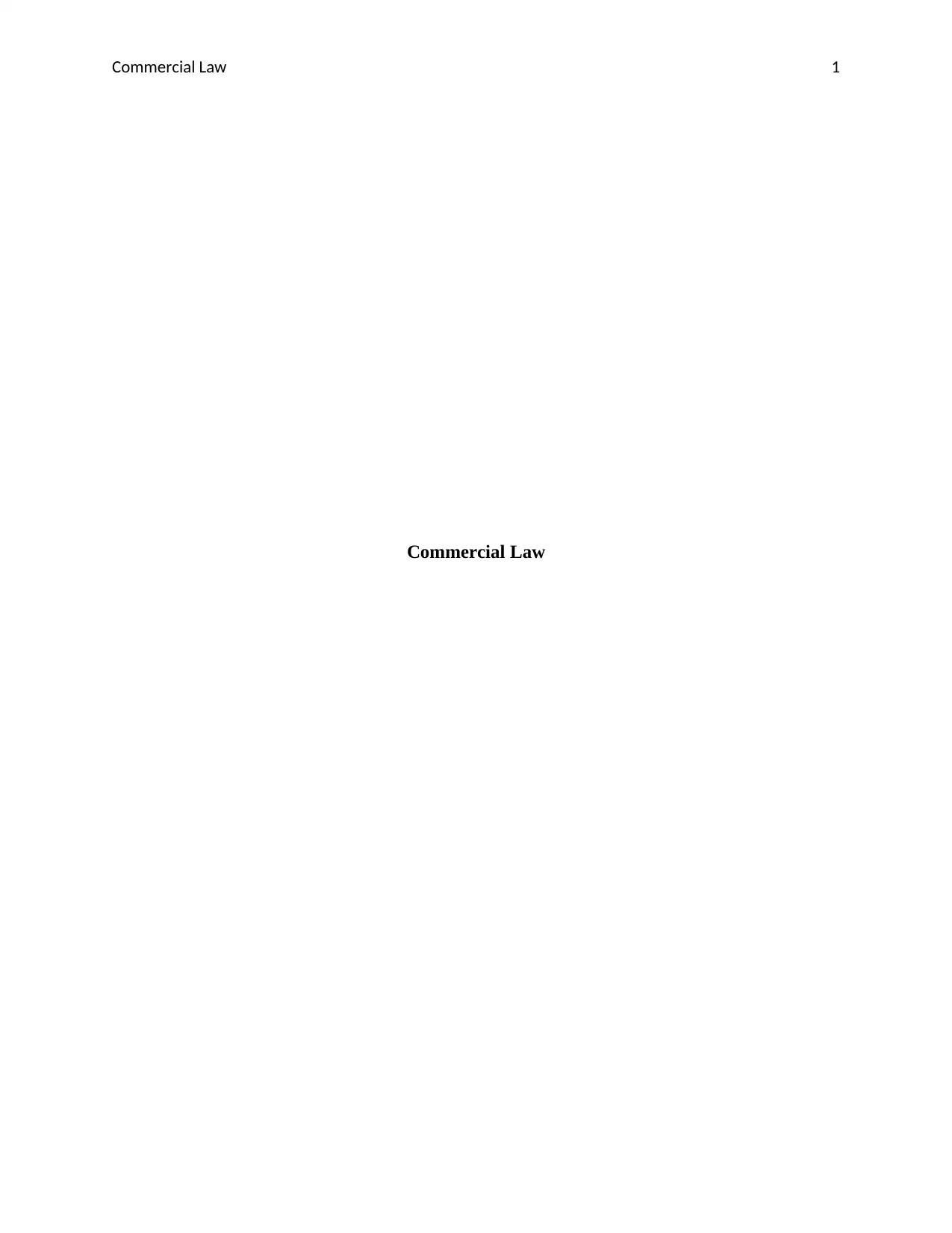
Commercial Law 1
Commercial Law
Commercial Law
Paraphrase This Document
Need a fresh take? Get an instant paraphrase of this document with our AI Paraphraser
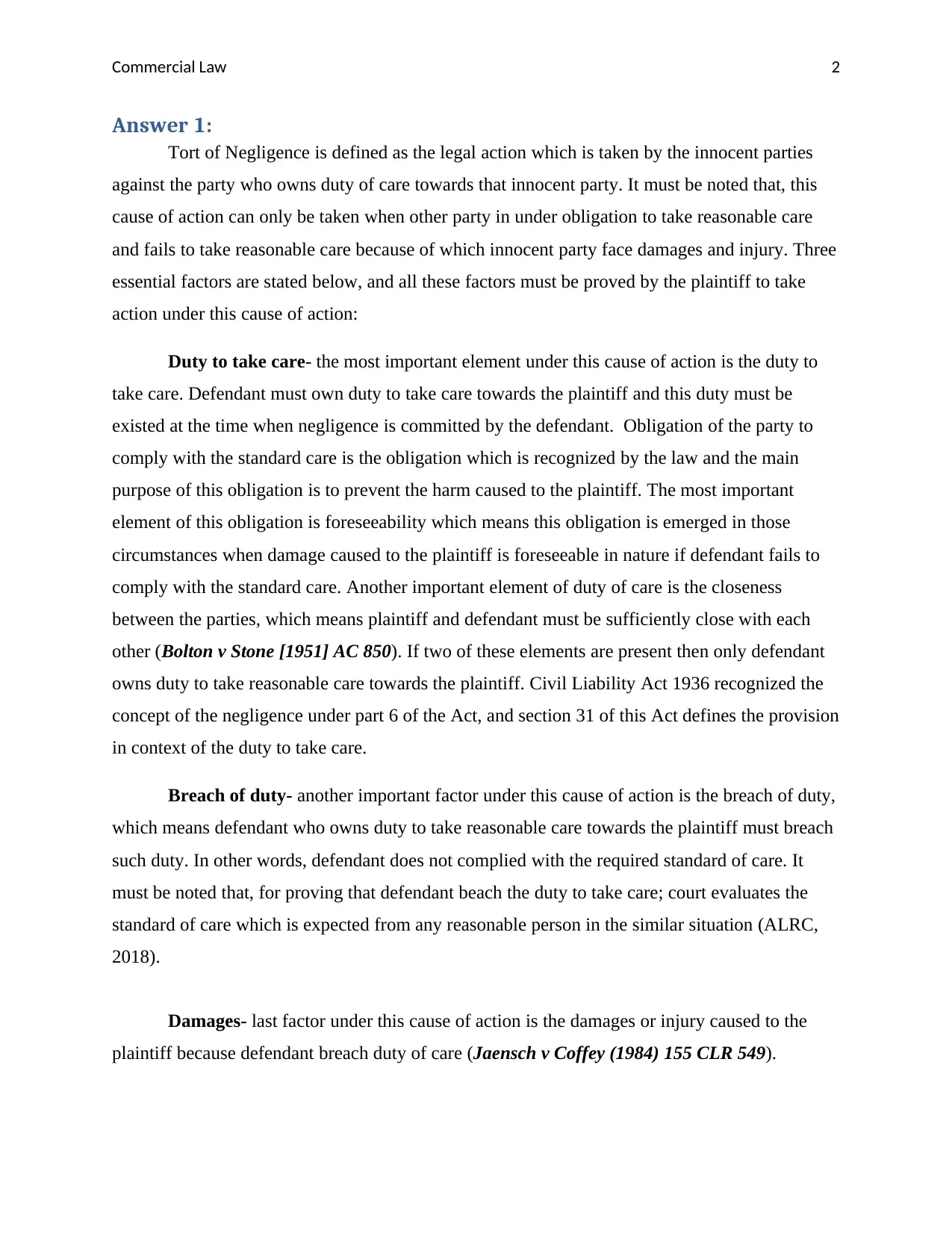
Commercial Law 2
Answer 1:
Tort of Negligence is defined as the legal action which is taken by the innocent parties
against the party who owns duty of care towards that innocent party. It must be noted that, this
cause of action can only be taken when other party in under obligation to take reasonable care
and fails to take reasonable care because of which innocent party face damages and injury. Three
essential factors are stated below, and all these factors must be proved by the plaintiff to take
action under this cause of action:
Duty to take care- the most important element under this cause of action is the duty to
take care. Defendant must own duty to take care towards the plaintiff and this duty must be
existed at the time when negligence is committed by the defendant. Obligation of the party to
comply with the standard care is the obligation which is recognized by the law and the main
purpose of this obligation is to prevent the harm caused to the plaintiff. The most important
element of this obligation is foreseeability which means this obligation is emerged in those
circumstances when damage caused to the plaintiff is foreseeable in nature if defendant fails to
comply with the standard care. Another important element of duty of care is the closeness
between the parties, which means plaintiff and defendant must be sufficiently close with each
other (Bolton v Stone [1951] AC 850). If two of these elements are present then only defendant
owns duty to take reasonable care towards the plaintiff. Civil Liability Act 1936 recognized the
concept of the negligence under part 6 of the Act, and section 31 of this Act defines the provision
in context of the duty to take care.
Breach of duty- another important factor under this cause of action is the breach of duty,
which means defendant who owns duty to take reasonable care towards the plaintiff must breach
such duty. In other words, defendant does not complied with the required standard of care. It
must be noted that, for proving that defendant beach the duty to take care; court evaluates the
standard of care which is expected from any reasonable person in the similar situation (ALRC,
2018).
Damages- last factor under this cause of action is the damages or injury caused to the
plaintiff because defendant breach duty of care (Jaensch v Coffey (1984) 155 CLR 549).
Answer 1:
Tort of Negligence is defined as the legal action which is taken by the innocent parties
against the party who owns duty of care towards that innocent party. It must be noted that, this
cause of action can only be taken when other party in under obligation to take reasonable care
and fails to take reasonable care because of which innocent party face damages and injury. Three
essential factors are stated below, and all these factors must be proved by the plaintiff to take
action under this cause of action:
Duty to take care- the most important element under this cause of action is the duty to
take care. Defendant must own duty to take care towards the plaintiff and this duty must be
existed at the time when negligence is committed by the defendant. Obligation of the party to
comply with the standard care is the obligation which is recognized by the law and the main
purpose of this obligation is to prevent the harm caused to the plaintiff. The most important
element of this obligation is foreseeability which means this obligation is emerged in those
circumstances when damage caused to the plaintiff is foreseeable in nature if defendant fails to
comply with the standard care. Another important element of duty of care is the closeness
between the parties, which means plaintiff and defendant must be sufficiently close with each
other (Bolton v Stone [1951] AC 850). If two of these elements are present then only defendant
owns duty to take reasonable care towards the plaintiff. Civil Liability Act 1936 recognized the
concept of the negligence under part 6 of the Act, and section 31 of this Act defines the provision
in context of the duty to take care.
Breach of duty- another important factor under this cause of action is the breach of duty,
which means defendant who owns duty to take reasonable care towards the plaintiff must breach
such duty. In other words, defendant does not complied with the required standard of care. It
must be noted that, for proving that defendant beach the duty to take care; court evaluates the
standard of care which is expected from any reasonable person in the similar situation (ALRC,
2018).
Damages- last factor under this cause of action is the damages or injury caused to the
plaintiff because defendant breach duty of care (Jaensch v Coffey (1984) 155 CLR 549).
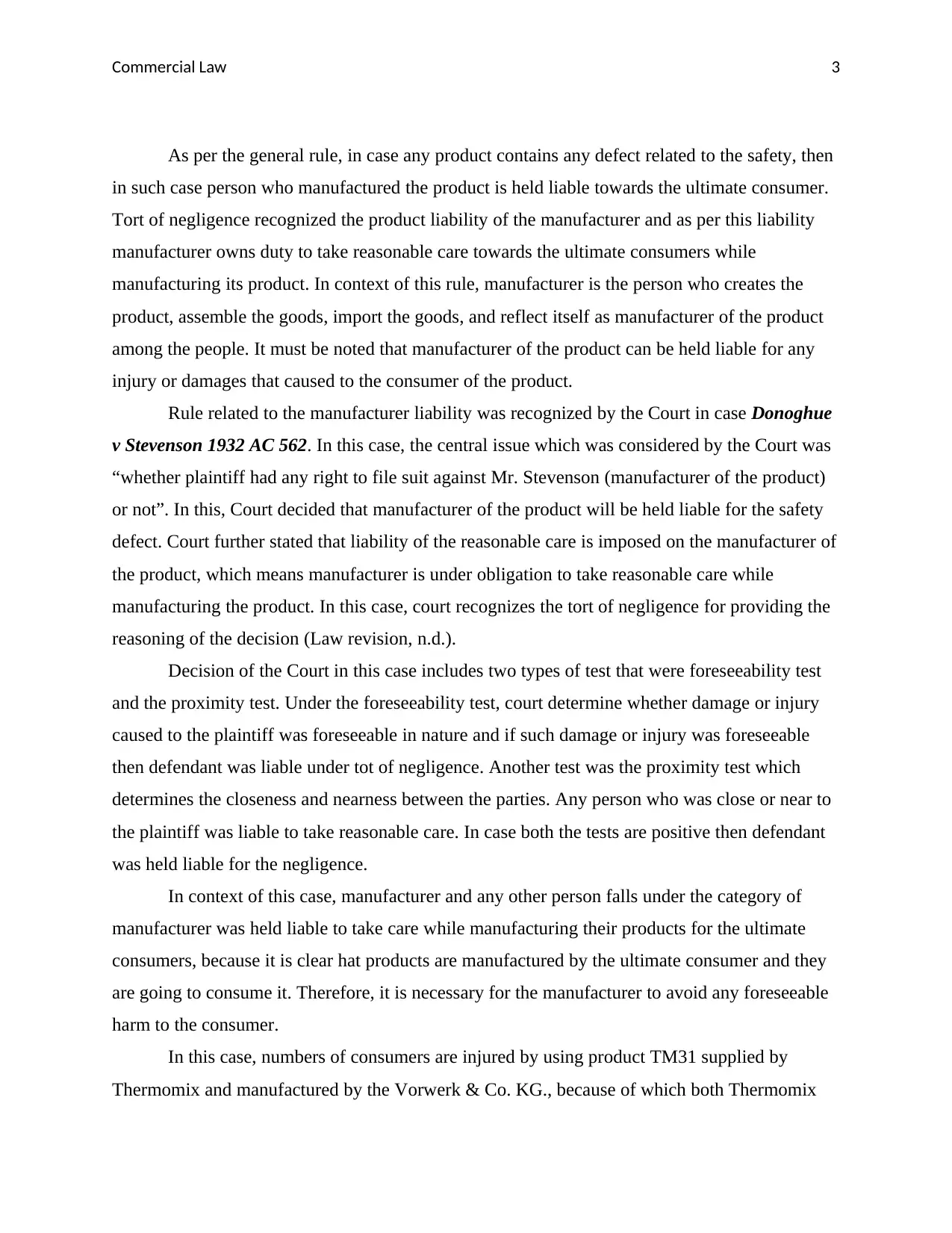
Commercial Law 3
As per the general rule, in case any product contains any defect related to the safety, then
in such case person who manufactured the product is held liable towards the ultimate consumer.
Tort of negligence recognized the product liability of the manufacturer and as per this liability
manufacturer owns duty to take reasonable care towards the ultimate consumers while
manufacturing its product. In context of this rule, manufacturer is the person who creates the
product, assemble the goods, import the goods, and reflect itself as manufacturer of the product
among the people. It must be noted that manufacturer of the product can be held liable for any
injury or damages that caused to the consumer of the product.
Rule related to the manufacturer liability was recognized by the Court in case Donoghue
v Stevenson 1932 AC 562. In this case, the central issue which was considered by the Court was
“whether plaintiff had any right to file suit against Mr. Stevenson (manufacturer of the product)
or not”. In this, Court decided that manufacturer of the product will be held liable for the safety
defect. Court further stated that liability of the reasonable care is imposed on the manufacturer of
the product, which means manufacturer is under obligation to take reasonable care while
manufacturing the product. In this case, court recognizes the tort of negligence for providing the
reasoning of the decision (Law revision, n.d.).
Decision of the Court in this case includes two types of test that were foreseeability test
and the proximity test. Under the foreseeability test, court determine whether damage or injury
caused to the plaintiff was foreseeable in nature and if such damage or injury was foreseeable
then defendant was liable under tot of negligence. Another test was the proximity test which
determines the closeness and nearness between the parties. Any person who was close or near to
the plaintiff was liable to take reasonable care. In case both the tests are positive then defendant
was held liable for the negligence.
In context of this case, manufacturer and any other person falls under the category of
manufacturer was held liable to take care while manufacturing their products for the ultimate
consumers, because it is clear hat products are manufactured by the ultimate consumer and they
are going to consume it. Therefore, it is necessary for the manufacturer to avoid any foreseeable
harm to the consumer.
In this case, numbers of consumers are injured by using product TM31 supplied by
Thermomix and manufactured by the Vorwerk & Co. KG., because of which both Thermomix
As per the general rule, in case any product contains any defect related to the safety, then
in such case person who manufactured the product is held liable towards the ultimate consumer.
Tort of negligence recognized the product liability of the manufacturer and as per this liability
manufacturer owns duty to take reasonable care towards the ultimate consumers while
manufacturing its product. In context of this rule, manufacturer is the person who creates the
product, assemble the goods, import the goods, and reflect itself as manufacturer of the product
among the people. It must be noted that manufacturer of the product can be held liable for any
injury or damages that caused to the consumer of the product.
Rule related to the manufacturer liability was recognized by the Court in case Donoghue
v Stevenson 1932 AC 562. In this case, the central issue which was considered by the Court was
“whether plaintiff had any right to file suit against Mr. Stevenson (manufacturer of the product)
or not”. In this, Court decided that manufacturer of the product will be held liable for the safety
defect. Court further stated that liability of the reasonable care is imposed on the manufacturer of
the product, which means manufacturer is under obligation to take reasonable care while
manufacturing the product. In this case, court recognizes the tort of negligence for providing the
reasoning of the decision (Law revision, n.d.).
Decision of the Court in this case includes two types of test that were foreseeability test
and the proximity test. Under the foreseeability test, court determine whether damage or injury
caused to the plaintiff was foreseeable in nature and if such damage or injury was foreseeable
then defendant was liable under tot of negligence. Another test was the proximity test which
determines the closeness and nearness between the parties. Any person who was close or near to
the plaintiff was liable to take reasonable care. In case both the tests are positive then defendant
was held liable for the negligence.
In context of this case, manufacturer and any other person falls under the category of
manufacturer was held liable to take care while manufacturing their products for the ultimate
consumers, because it is clear hat products are manufactured by the ultimate consumer and they
are going to consume it. Therefore, it is necessary for the manufacturer to avoid any foreseeable
harm to the consumer.
In this case, numbers of consumers are injured by using product TM31 supplied by
Thermomix and manufactured by the Vorwerk & Co. KG., because of which both Thermomix
You're viewing a preview
Unlock full access by subscribing today!
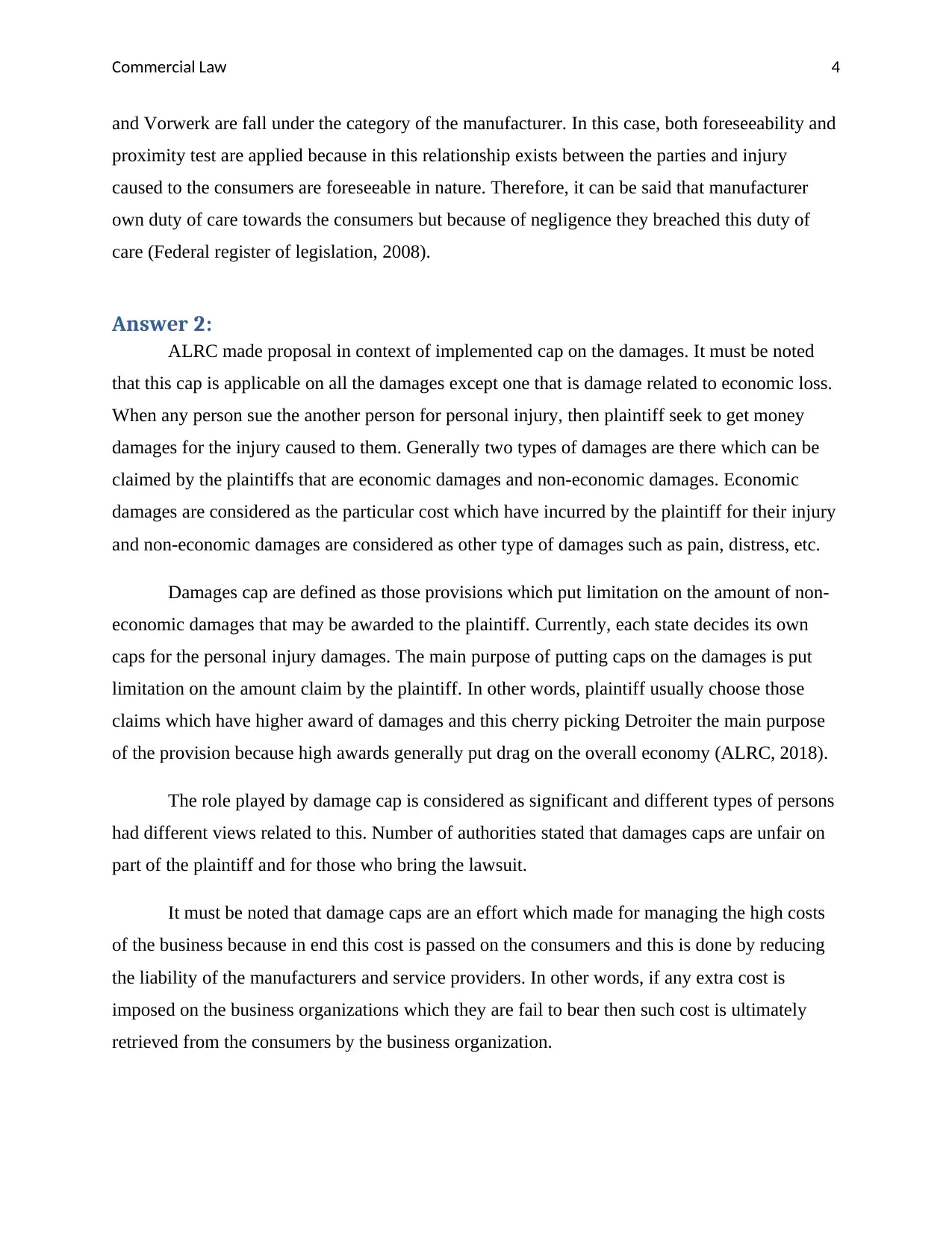
Commercial Law 4
and Vorwerk are fall under the category of the manufacturer. In this case, both foreseeability and
proximity test are applied because in this relationship exists between the parties and injury
caused to the consumers are foreseeable in nature. Therefore, it can be said that manufacturer
own duty of care towards the consumers but because of negligence they breached this duty of
care (Federal register of legislation, 2008).
Answer 2:
ALRC made proposal in context of implemented cap on the damages. It must be noted
that this cap is applicable on all the damages except one that is damage related to economic loss.
When any person sue the another person for personal injury, then plaintiff seek to get money
damages for the injury caused to them. Generally two types of damages are there which can be
claimed by the plaintiffs that are economic damages and non-economic damages. Economic
damages are considered as the particular cost which have incurred by the plaintiff for their injury
and non-economic damages are considered as other type of damages such as pain, distress, etc.
Damages cap are defined as those provisions which put limitation on the amount of non-
economic damages that may be awarded to the plaintiff. Currently, each state decides its own
caps for the personal injury damages. The main purpose of putting caps on the damages is put
limitation on the amount claim by the plaintiff. In other words, plaintiff usually choose those
claims which have higher award of damages and this cherry picking Detroiter the main purpose
of the provision because high awards generally put drag on the overall economy (ALRC, 2018).
The role played by damage cap is considered as significant and different types of persons
had different views related to this. Number of authorities stated that damages caps are unfair on
part of the plaintiff and for those who bring the lawsuit.
It must be noted that damage caps are an effort which made for managing the high costs
of the business because in end this cost is passed on the consumers and this is done by reducing
the liability of the manufacturers and service providers. In other words, if any extra cost is
imposed on the business organizations which they are fail to bear then such cost is ultimately
retrieved from the consumers by the business organization.
and Vorwerk are fall under the category of the manufacturer. In this case, both foreseeability and
proximity test are applied because in this relationship exists between the parties and injury
caused to the consumers are foreseeable in nature. Therefore, it can be said that manufacturer
own duty of care towards the consumers but because of negligence they breached this duty of
care (Federal register of legislation, 2008).
Answer 2:
ALRC made proposal in context of implemented cap on the damages. It must be noted
that this cap is applicable on all the damages except one that is damage related to economic loss.
When any person sue the another person for personal injury, then plaintiff seek to get money
damages for the injury caused to them. Generally two types of damages are there which can be
claimed by the plaintiffs that are economic damages and non-economic damages. Economic
damages are considered as the particular cost which have incurred by the plaintiff for their injury
and non-economic damages are considered as other type of damages such as pain, distress, etc.
Damages cap are defined as those provisions which put limitation on the amount of non-
economic damages that may be awarded to the plaintiff. Currently, each state decides its own
caps for the personal injury damages. The main purpose of putting caps on the damages is put
limitation on the amount claim by the plaintiff. In other words, plaintiff usually choose those
claims which have higher award of damages and this cherry picking Detroiter the main purpose
of the provision because high awards generally put drag on the overall economy (ALRC, 2018).
The role played by damage cap is considered as significant and different types of persons
had different views related to this. Number of authorities stated that damages caps are unfair on
part of the plaintiff and for those who bring the lawsuit.
It must be noted that damage caps are an effort which made for managing the high costs
of the business because in end this cost is passed on the consumers and this is done by reducing
the liability of the manufacturers and service providers. In other words, if any extra cost is
imposed on the business organizations which they are fail to bear then such cost is ultimately
retrieved from the consumers by the business organization.
Paraphrase This Document
Need a fresh take? Get an instant paraphrase of this document with our AI Paraphraser
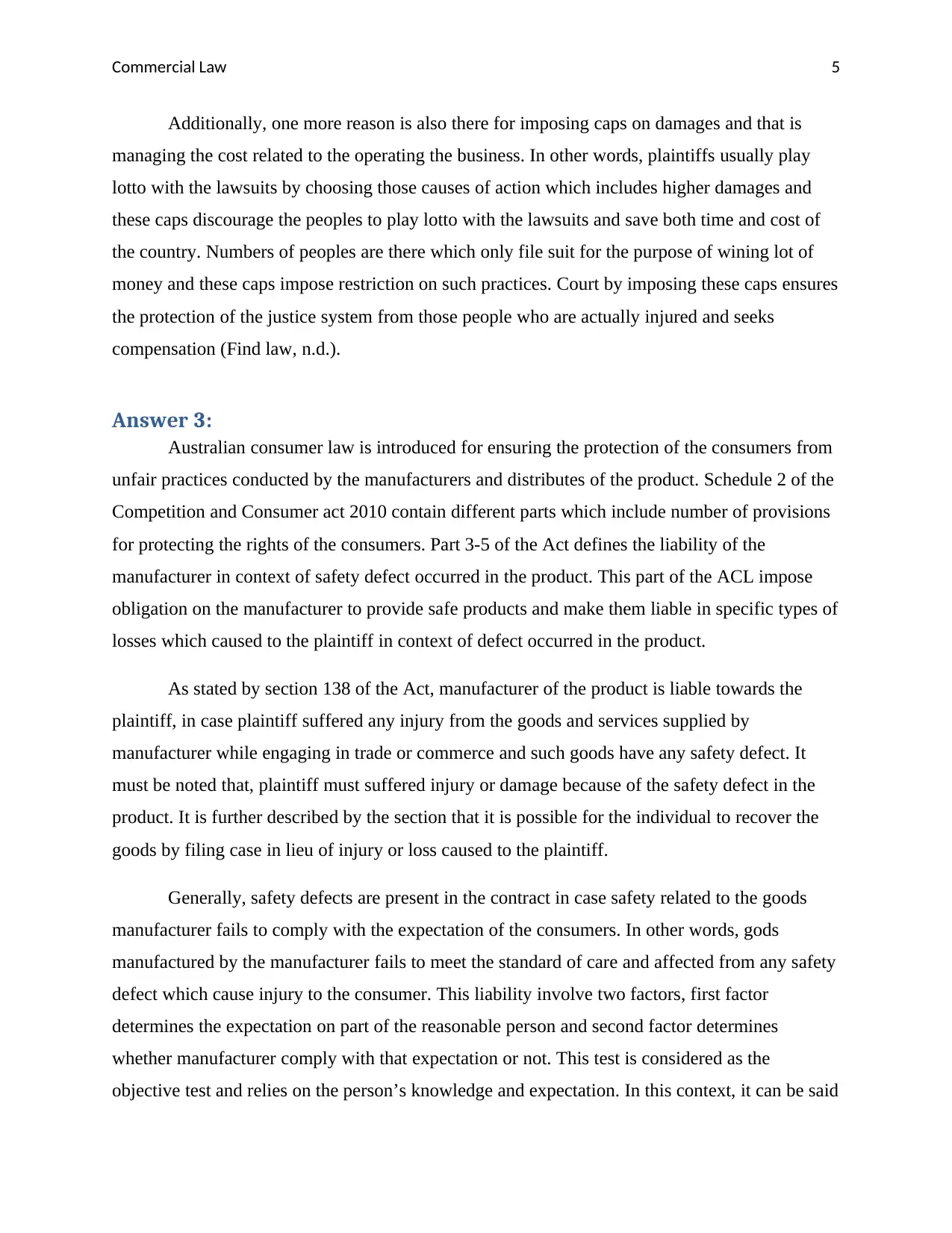
Commercial Law 5
Additionally, one more reason is also there for imposing caps on damages and that is
managing the cost related to the operating the business. In other words, plaintiffs usually play
lotto with the lawsuits by choosing those causes of action which includes higher damages and
these caps discourage the peoples to play lotto with the lawsuits and save both time and cost of
the country. Numbers of peoples are there which only file suit for the purpose of wining lot of
money and these caps impose restriction on such practices. Court by imposing these caps ensures
the protection of the justice system from those people who are actually injured and seeks
compensation (Find law, n.d.).
Answer 3:
Australian consumer law is introduced for ensuring the protection of the consumers from
unfair practices conducted by the manufacturers and distributes of the product. Schedule 2 of the
Competition and Consumer act 2010 contain different parts which include number of provisions
for protecting the rights of the consumers. Part 3-5 of the Act defines the liability of the
manufacturer in context of safety defect occurred in the product. This part of the ACL impose
obligation on the manufacturer to provide safe products and make them liable in specific types of
losses which caused to the plaintiff in context of defect occurred in the product.
As stated by section 138 of the Act, manufacturer of the product is liable towards the
plaintiff, in case plaintiff suffered any injury from the goods and services supplied by
manufacturer while engaging in trade or commerce and such goods have any safety defect. It
must be noted that, plaintiff must suffered injury or damage because of the safety defect in the
product. It is further described by the section that it is possible for the individual to recover the
goods by filing case in lieu of injury or loss caused to the plaintiff.
Generally, safety defects are present in the contract in case safety related to the goods
manufacturer fails to comply with the expectation of the consumers. In other words, gods
manufactured by the manufacturer fails to meet the standard of care and affected from any safety
defect which cause injury to the consumer. This liability involve two factors, first factor
determines the expectation on part of the reasonable person and second factor determines
whether manufacturer comply with that expectation or not. This test is considered as the
objective test and relies on the person’s knowledge and expectation. In this context, it can be said
Additionally, one more reason is also there for imposing caps on damages and that is
managing the cost related to the operating the business. In other words, plaintiffs usually play
lotto with the lawsuits by choosing those causes of action which includes higher damages and
these caps discourage the peoples to play lotto with the lawsuits and save both time and cost of
the country. Numbers of peoples are there which only file suit for the purpose of wining lot of
money and these caps impose restriction on such practices. Court by imposing these caps ensures
the protection of the justice system from those people who are actually injured and seeks
compensation (Find law, n.d.).
Answer 3:
Australian consumer law is introduced for ensuring the protection of the consumers from
unfair practices conducted by the manufacturers and distributes of the product. Schedule 2 of the
Competition and Consumer act 2010 contain different parts which include number of provisions
for protecting the rights of the consumers. Part 3-5 of the Act defines the liability of the
manufacturer in context of safety defect occurred in the product. This part of the ACL impose
obligation on the manufacturer to provide safe products and make them liable in specific types of
losses which caused to the plaintiff in context of defect occurred in the product.
As stated by section 138 of the Act, manufacturer of the product is liable towards the
plaintiff, in case plaintiff suffered any injury from the goods and services supplied by
manufacturer while engaging in trade or commerce and such goods have any safety defect. It
must be noted that, plaintiff must suffered injury or damage because of the safety defect in the
product. It is further described by the section that it is possible for the individual to recover the
goods by filing case in lieu of injury or loss caused to the plaintiff.
Generally, safety defects are present in the contract in case safety related to the goods
manufacturer fails to comply with the expectation of the consumers. In other words, gods
manufactured by the manufacturer fails to meet the standard of care and affected from any safety
defect which cause injury to the consumer. This liability involve two factors, first factor
determines the expectation on part of the reasonable person and second factor determines
whether manufacturer comply with that expectation or not. This test is considered as the
objective test and relies on the person’s knowledge and expectation. In this context, it can be said
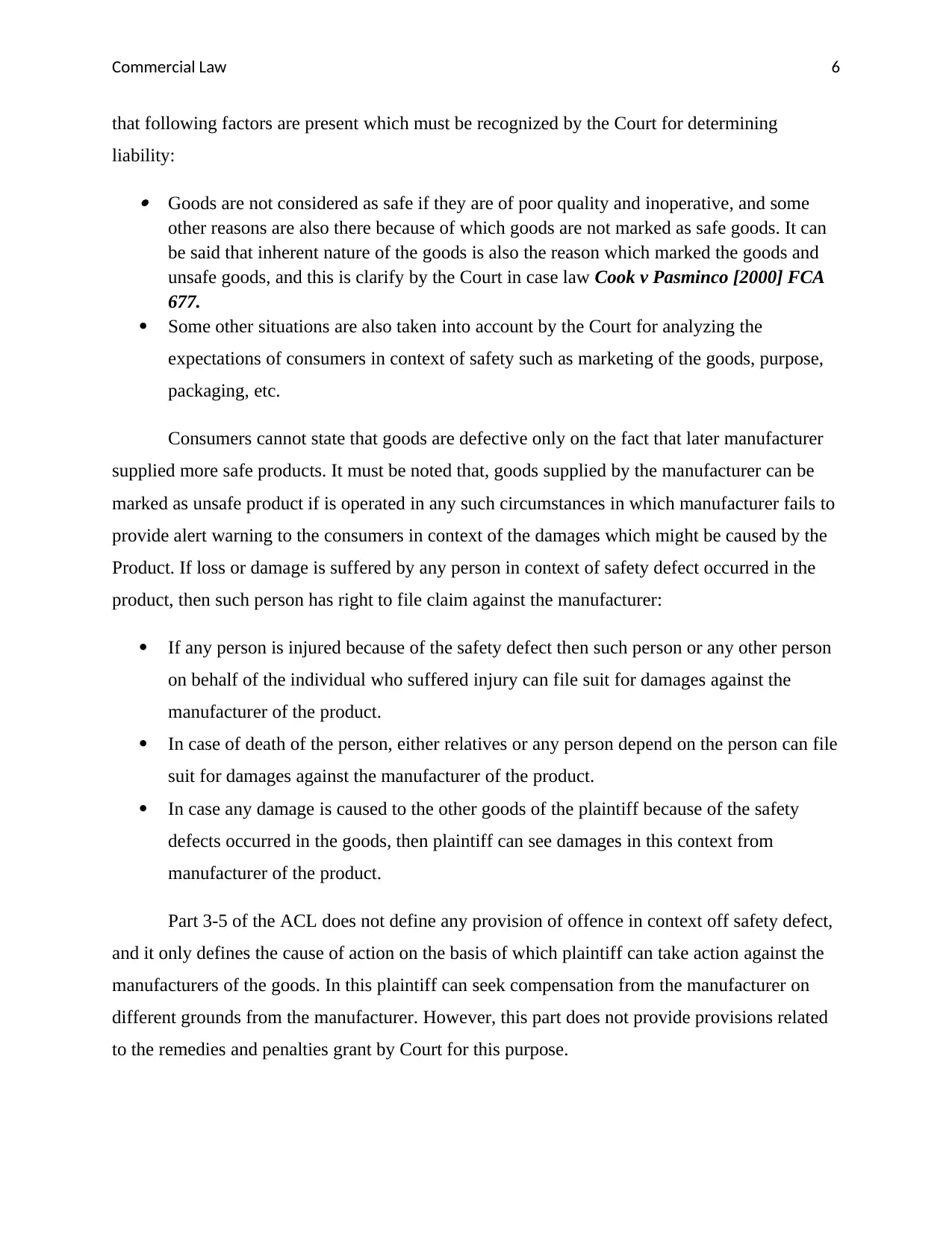
Commercial Law 6
that following factors are present which must be recognized by the Court for determining
liability:
Goods are not considered as safe if they are of poor quality and inoperative, and some
other reasons are also there because of which goods are not marked as safe goods. It can
be said that inherent nature of the goods is also the reason which marked the goods and
unsafe goods, and this is clarify by the Court in case law Cook v Pasminco [2000] FCA
677.
Some other situations are also taken into account by the Court for analyzing the
expectations of consumers in context of safety such as marketing of the goods, purpose,
packaging, etc.
Consumers cannot state that goods are defective only on the fact that later manufacturer
supplied more safe products. It must be noted that, goods supplied by the manufacturer can be
marked as unsafe product if is operated in any such circumstances in which manufacturer fails to
provide alert warning to the consumers in context of the damages which might be caused by the
Product. If loss or damage is suffered by any person in context of safety defect occurred in the
product, then such person has right to file claim against the manufacturer:
If any person is injured because of the safety defect then such person or any other person
on behalf of the individual who suffered injury can file suit for damages against the
manufacturer of the product.
In case of death of the person, either relatives or any person depend on the person can file
suit for damages against the manufacturer of the product.
In case any damage is caused to the other goods of the plaintiff because of the safety
defects occurred in the goods, then plaintiff can see damages in this context from
manufacturer of the product.
Part 3-5 of the ACL does not define any provision of offence in context off safety defect,
and it only defines the cause of action on the basis of which plaintiff can take action against the
manufacturers of the goods. In this plaintiff can seek compensation from the manufacturer on
different grounds from the manufacturer. However, this part does not provide provisions related
to the remedies and penalties grant by Court for this purpose.
that following factors are present which must be recognized by the Court for determining
liability:
Goods are not considered as safe if they are of poor quality and inoperative, and some
other reasons are also there because of which goods are not marked as safe goods. It can
be said that inherent nature of the goods is also the reason which marked the goods and
unsafe goods, and this is clarify by the Court in case law Cook v Pasminco [2000] FCA
677.
Some other situations are also taken into account by the Court for analyzing the
expectations of consumers in context of safety such as marketing of the goods, purpose,
packaging, etc.
Consumers cannot state that goods are defective only on the fact that later manufacturer
supplied more safe products. It must be noted that, goods supplied by the manufacturer can be
marked as unsafe product if is operated in any such circumstances in which manufacturer fails to
provide alert warning to the consumers in context of the damages which might be caused by the
Product. If loss or damage is suffered by any person in context of safety defect occurred in the
product, then such person has right to file claim against the manufacturer:
If any person is injured because of the safety defect then such person or any other person
on behalf of the individual who suffered injury can file suit for damages against the
manufacturer of the product.
In case of death of the person, either relatives or any person depend on the person can file
suit for damages against the manufacturer of the product.
In case any damage is caused to the other goods of the plaintiff because of the safety
defects occurred in the goods, then plaintiff can see damages in this context from
manufacturer of the product.
Part 3-5 of the ACL does not define any provision of offence in context off safety defect,
and it only defines the cause of action on the basis of which plaintiff can take action against the
manufacturers of the goods. In this plaintiff can seek compensation from the manufacturer on
different grounds from the manufacturer. However, this part does not provide provisions related
to the remedies and penalties grant by Court for this purpose.
You're viewing a preview
Unlock full access by subscribing today!
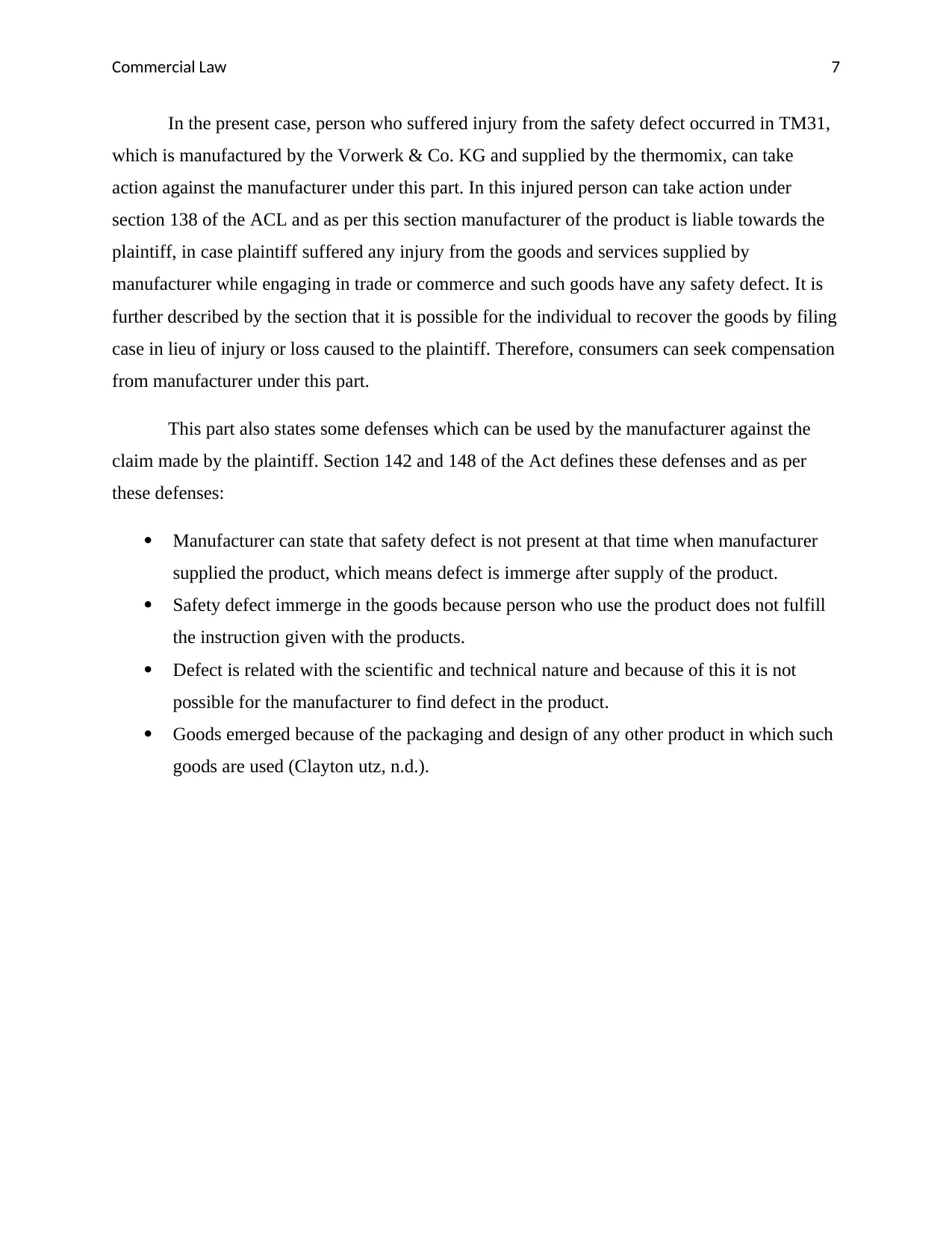
Commercial Law 7
In the present case, person who suffered injury from the safety defect occurred in TM31,
which is manufactured by the Vorwerk & Co. KG and supplied by the thermomix, can take
action against the manufacturer under this part. In this injured person can take action under
section 138 of the ACL and as per this section manufacturer of the product is liable towards the
plaintiff, in case plaintiff suffered any injury from the goods and services supplied by
manufacturer while engaging in trade or commerce and such goods have any safety defect. It is
further described by the section that it is possible for the individual to recover the goods by filing
case in lieu of injury or loss caused to the plaintiff. Therefore, consumers can seek compensation
from manufacturer under this part.
This part also states some defenses which can be used by the manufacturer against the
claim made by the plaintiff. Section 142 and 148 of the Act defines these defenses and as per
these defenses:
Manufacturer can state that safety defect is not present at that time when manufacturer
supplied the product, which means defect is immerge after supply of the product.
Safety defect immerge in the goods because person who use the product does not fulfill
the instruction given with the products.
Defect is related with the scientific and technical nature and because of this it is not
possible for the manufacturer to find defect in the product.
Goods emerged because of the packaging and design of any other product in which such
goods are used (Clayton utz, n.d.).
In the present case, person who suffered injury from the safety defect occurred in TM31,
which is manufactured by the Vorwerk & Co. KG and supplied by the thermomix, can take
action against the manufacturer under this part. In this injured person can take action under
section 138 of the ACL and as per this section manufacturer of the product is liable towards the
plaintiff, in case plaintiff suffered any injury from the goods and services supplied by
manufacturer while engaging in trade or commerce and such goods have any safety defect. It is
further described by the section that it is possible for the individual to recover the goods by filing
case in lieu of injury or loss caused to the plaintiff. Therefore, consumers can seek compensation
from manufacturer under this part.
This part also states some defenses which can be used by the manufacturer against the
claim made by the plaintiff. Section 142 and 148 of the Act defines these defenses and as per
these defenses:
Manufacturer can state that safety defect is not present at that time when manufacturer
supplied the product, which means defect is immerge after supply of the product.
Safety defect immerge in the goods because person who use the product does not fulfill
the instruction given with the products.
Defect is related with the scientific and technical nature and because of this it is not
possible for the manufacturer to find defect in the product.
Goods emerged because of the packaging and design of any other product in which such
goods are used (Clayton utz, n.d.).
Paraphrase This Document
Need a fresh take? Get an instant paraphrase of this document with our AI Paraphraser
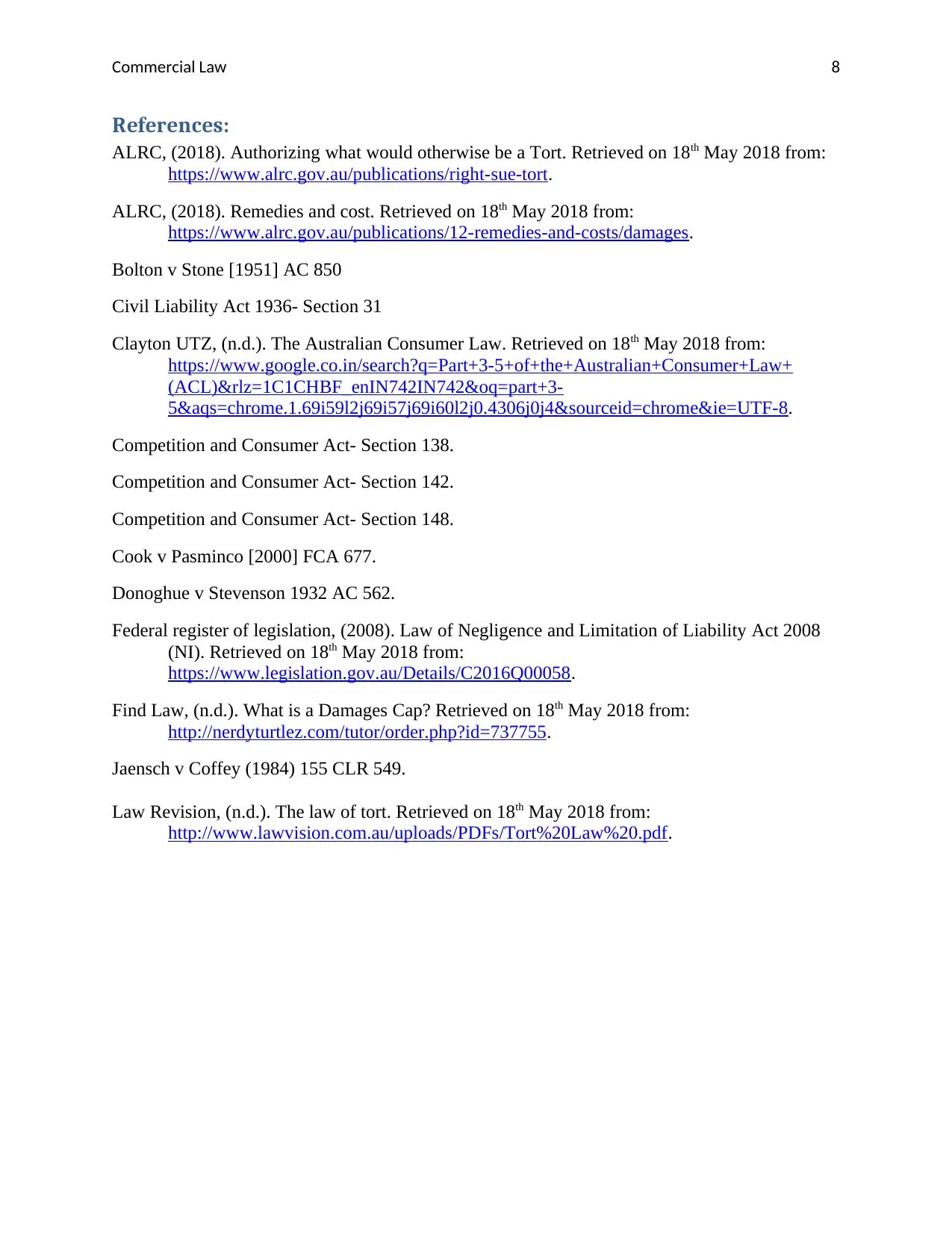
Commercial Law 8
References:
ALRC, (2018). Authorizing what would otherwise be a Tort. Retrieved on 18th May 2018 from:
https://www.alrc.gov.au/publications/right-sue-tort.
ALRC, (2018). Remedies and cost. Retrieved on 18th May 2018 from:
https://www.alrc.gov.au/publications/12-remedies-and-costs/damages.
Bolton v Stone [1951] AC 850
Civil Liability Act 1936- Section 31
Clayton UTZ, (n.d.). The Australian Consumer Law. Retrieved on 18th May 2018 from:
https://www.google.co.in/search?q=Part+3-5+of+the+Australian+Consumer+Law+
(ACL)&rlz=1C1CHBF_enIN742IN742&oq=part+3-
5&aqs=chrome.1.69i59l2j69i57j69i60l2j0.4306j0j4&sourceid=chrome&ie=UTF-8.
Competition and Consumer Act- Section 138.
Competition and Consumer Act- Section 142.
Competition and Consumer Act- Section 148.
Cook v Pasminco [2000] FCA 677.
Donoghue v Stevenson 1932 AC 562.
Federal register of legislation, (2008). Law of Negligence and Limitation of Liability Act 2008
(NI). Retrieved on 18th May 2018 from:
https://www.legislation.gov.au/Details/C2016Q00058.
Find Law, (n.d.). What is a Damages Cap? Retrieved on 18th May 2018 from:
http://nerdyturtlez.com/tutor/order.php?id=737755.
Jaensch v Coffey (1984) 155 CLR 549.
Law Revision, (n.d.). The law of tort. Retrieved on 18th May 2018 from:
http://www.lawvision.com.au/uploads/PDFs/Tort%20Law%20.pdf.
References:
ALRC, (2018). Authorizing what would otherwise be a Tort. Retrieved on 18th May 2018 from:
https://www.alrc.gov.au/publications/right-sue-tort.
ALRC, (2018). Remedies and cost. Retrieved on 18th May 2018 from:
https://www.alrc.gov.au/publications/12-remedies-and-costs/damages.
Bolton v Stone [1951] AC 850
Civil Liability Act 1936- Section 31
Clayton UTZ, (n.d.). The Australian Consumer Law. Retrieved on 18th May 2018 from:
https://www.google.co.in/search?q=Part+3-5+of+the+Australian+Consumer+Law+
(ACL)&rlz=1C1CHBF_enIN742IN742&oq=part+3-
5&aqs=chrome.1.69i59l2j69i57j69i60l2j0.4306j0j4&sourceid=chrome&ie=UTF-8.
Competition and Consumer Act- Section 138.
Competition and Consumer Act- Section 142.
Competition and Consumer Act- Section 148.
Cook v Pasminco [2000] FCA 677.
Donoghue v Stevenson 1932 AC 562.
Federal register of legislation, (2008). Law of Negligence and Limitation of Liability Act 2008
(NI). Retrieved on 18th May 2018 from:
https://www.legislation.gov.au/Details/C2016Q00058.
Find Law, (n.d.). What is a Damages Cap? Retrieved on 18th May 2018 from:
http://nerdyturtlez.com/tutor/order.php?id=737755.
Jaensch v Coffey (1984) 155 CLR 549.
Law Revision, (n.d.). The law of tort. Retrieved on 18th May 2018 from:
http://www.lawvision.com.au/uploads/PDFs/Tort%20Law%20.pdf.
1 out of 8
Related Documents
Your All-in-One AI-Powered Toolkit for Academic Success.
+13062052269
info@desklib.com
Available 24*7 on WhatsApp / Email
![[object Object]](/_next/static/media/star-bottom.7253800d.svg)
Unlock your academic potential
© 2024 | Zucol Services PVT LTD | All rights reserved.





